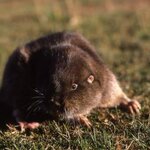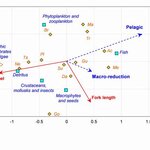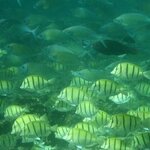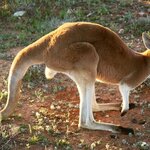Ecology & Zoology

It's uncommon to identify a new species of mammal these days, but four new species of Ctenomys, a genus of gopher-like mammal commonly called tuco-tucos and found throughout much of South America, have been identified.
Tuco-tucos are burrowing rodents ranging from 7 to 12 inches long and weighing less than a pound. They demonstrate the broad range of biological diversity in the lowlands and central valleys of Bolivia, where all four new species were found.
Three of the newly identified animals -- Ctenomys erikacuellarae or Erika's tuco-tuco; Ctenomys andersoni, or Anderson's cujuchi; and…

When global warming happens, Atlantic salmon will likely be just fine. They have shown a surprisingly good capacity to adjust to warmer temperatures that are being seen with climate change.
The finding about Atlantic species adds to similar research about the heat tolerance of Pacific salmon. Scientists studied wild salmon from two European rivers. They compared a cold-water population from Norway's northern Alta River, where water temperatures have not exceeded 18 C for 30 years, with warm-water populations from France's Dordogne River, located 3,000 kilometres south, where annual water…

A new study finds that Silverback gorillas appear to use odor as a form of communication with other gorillas.
Mammals communicate socially through visual, auditory, and chemical signals. The chemical sense is in fact the oldest sense, shared by all organisms including bacteria, and some studies suggest that humans also participate in social chemical signaling. However, not much is known about this type of signaling in closely related hominoids, like wild apes.
To better understand chemical communication in apes, the researchers analyzed odor strength in relation to arousal levels in a…

We're all aware of the concept of an ecological food niche and a web that extends from it - but it is pretty simplistic and easily leads to claims that if species X is used too much, we are doomed. Literate people know that 99.999% of species had gone extinct and we never even knew they existed.
But some are more important than others and so researchers have taught to make that abstract concept real. Biologists in a new paper outlined the position of fourteen fish species in relationship to their food in a four-dimensional food diagram.
The ecological ‘niche’ concept was first used in…

A new systematic review says that no-take zones in Belize are helping rebuildeconomically valuable species such as lobster, conch, and fish - and perhaps also helping to re-colonize nearby reef areas.
The literature in the review was from no-take areas around the world.
According to other papers, the recovery of lobster, conch, and other exploited species within marine protected areas with no-take zones, or fully protected reserves, could take as little as 1-6 years. Full recovery of exploited species, however, could take decades.
Fishermen processing conch in Belize's coastal…
If global warming is causing extinction, it isn't happening to Adélie penguins in the Southern Ocean.
Adélie penguins have long been considered a key indicator species to monitor in order to understand the effects of climate change and fishing in the Southern Ocean. New evidence shows that the population is 3.79 million breeding pairs - 53 percent larger than previously estimated.
High-resolution satellite imagery permits regular monitoring of Adélie penguins across their entire breeding range, and by extension the health of the Southern Ocean ecosystem. The authors combined that with…

The migration of tropical fish poses a serious threat to the areas they invade, because they overgraze on kelp forests and seagrass meadows. The harmful impact of tropical fish is already evident in southern Japanese waters and the eastern Mediterranean, where there have been dramatic declines in kelps.
There is also emerging evidence in Australia and the US that the spread of tropical fish towards the poles is causing damage in the areas they enter.
The authors blame the increased fish on warming oceans due to climate change that have led to hotspots in regions where the currents that…

Researchers at the Royal Veterinary College have identified a highly specialized ligament structure that is thought to prevent giraffes' legs from collapsing under the immense weight of these animals.
"Giraffes are heavy animals (around 1000 kg), but have unusually skinny limb bones for an animal of this size" explained lead investigator Christ Basu, a PhD student in the Structure&Motion Lab. "This means their leg bones are under high levels of mechanical stress."
In giraffes, the equivalents to our metatarsal bone (in the foot) and metacarpal bone (in the hand) are extremely elongated,…

The first molecular characterization of the African elephant's adipose tissue, body fat, will form the basis of future studies aimed at securing the health and future survival of captive elephants.
The population of captive elephants, both Asian and African, in Europe and North America is not self-sustaining, largely due to poor fertility and fewer baby elephants being born. Captive elephants might face demographic extinction in North American zoos within the next 50 years if the reproductive issues aren't solved.
A new study in PLOS One carried out by a team of scientists at the…

A new study has found that kangaroos, commonly viewed as two-legged hoppers, move with a “pentapedal” gait, planting their tails on the ground in combination with their front and hind legs.
What’s remarkable is that the tail is anatomically quite different, being made up of more than 20 vertebrae taking on the roles of our feet, calves and thigh bones. “Animals have discovered many uses for their tails,” says professor Max Donelan of Simon Fraser University’s Locomotion Laboratory, “but as far as we know, this is the first use of one as a leg.
“We measured the forces the tail…